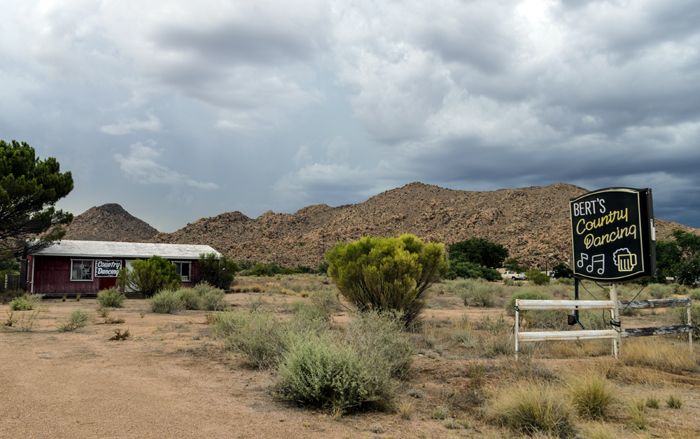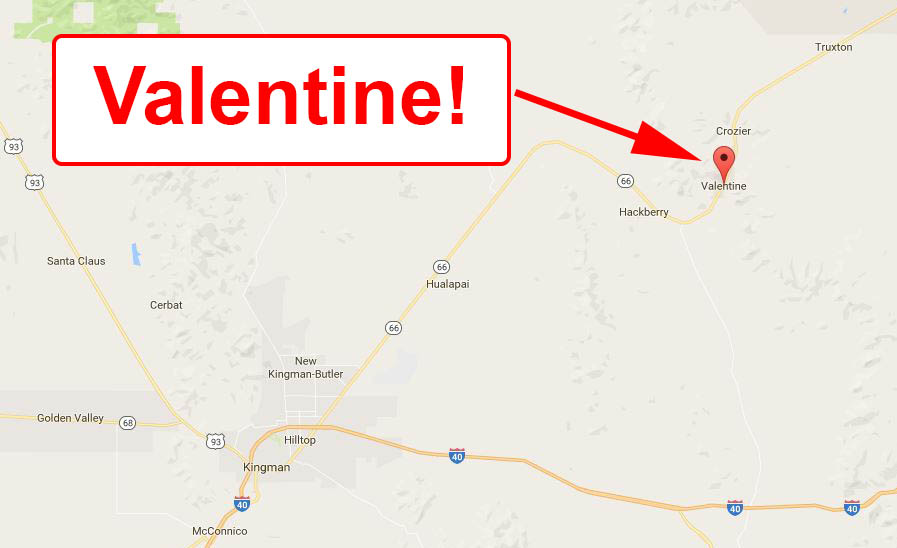
Valentine, Arizona: Where Desert Dust Meets Cupid’s Arrow
The name itself conjures images of crimson roses, heart-shaped chocolates, and whispered promises under a starry sky. "Valentine." It’s a word synonymous with romance, passion, and the celebration of love. So, when one hears of a place called Valentine, Arizona, the mind naturally drifts to a desert oasis where cupids might flutter among saguaro cacti, and every sunset is painted in hues of passionate red.
The reality, as is often the case with the American West, is far more rugged, understated, and surprisingly enduring. Valentine, Arizona, is not a bustling hub of romantic getaways or a picturesque village adorned with cherubic statues. It is, in essence, a whisper on the wind, a dot on the map, and a testament to the unexpected ways a name can shape a place’s destiny. Yet, for a few weeks each year, this unassuming outpost in the heart of Mohave County becomes a global epicenter for expressions of affection, all thanks to a simple, yet profoundly meaningful, act: its unique postmark.
The Heart of the Matter: A Stamp of Love

The annual pilgrimage to Valentine, Arizona, begins weeks before February 14th. From late January until the days leading up to Valentine’s Day, envelopes pour into its tiny post office, sometimes numbering in the tens of thousands. These aren’t just local letters; they arrive from every corner of the United States and indeed, from across the globe – from Japan, Germany, Australia, and beyond. Each sender has one specific request: for their card or letter to bear the coveted Valentine, Arizona, postmark.
"It’s a tradition that goes back decades," explains a former postmaster, Ms. Eleanor Vance, who oversaw countless February rushes. "People want that unique stamp on their Valentine’s Day greetings. It adds an extra layer of thought, a special touch that a regular postmark just can’t replicate." The post office, often staffed by just one or two individuals, transforms into a hub of meticulous hand-stamping. Each envelope is carefully processed, imprinting the date and the town’s evocative name, before being sent back into the postal system, destined for loved ones worldwide.
This annual ritual is more than just a logistical feat; it’s a cultural phenomenon. For many, sending a card through Valentine, Arizona, is a cherished part of their Valentine’s Day tradition, a small act of devotion that connects them to this remote desert outpost. It’s a tangible link between a romantic sentiment and a physical place, transforming an otherwise anonymous piece of mail into a cherished keepsake. The sheer volume of mail is astonishing for a town that, by most measures, barely registers as a community. It speaks to the enduring power of symbolism and the human desire to make gestures of love truly special.
Beyond the Postmark: A Glimpse into the Past
But what lies beyond the famed post office? To understand Valentine, Arizona, one must look past the holiday and delve into its rich, if understated, history. The truth about its name is, perhaps, the first charming disillusionment for the romantically inclined. The town was not named by a lovestruck pioneer or a hopeful prospector. Instead, it owes its moniker to Robert G. Valentine, an agent for the Atchison, Topeka and Santa Fe Railway. In the late 1890s, the railroad was expanding westward, and new sidings and stations were named after prominent figures associated with the company. Robert G. Valentine, a man of industry rather than romance, lent his name to this particular railroad stop.
The railroad was the lifeblood of many Western towns, and Valentine was no exception. It served as a vital watering stop and a shipping point for cattle ranchers and, for a time, mica and beryl miners in the surrounding rugged hills. The landscape itself is classic Mohave Desert: vast, open, punctuated by jagged mountain ranges, sparse creosote bushes, and the iconic, whimsical Joshua trees that stand like sentinels in the arid expanse. The silence here is profound, broken only by the whisper of the wind, the distant rumble of a train, or the occasional cry of a hawk circling overhead.
Native Roots and Route 66 Dreams
Valentine’s history is also deeply intertwined with the Hualapai Tribe, whose ancestral lands encompass much of the surrounding territory. The Hualapai people, "People of the Tall Pines," have inhabited this region for centuries, their culture and traditions shaped by the very landscape that defines Valentine. Peach Springs, the tribal capital, lies just a short distance away, serving as a vibrant center for the Hualapai nation.

Perhaps one of Valentine’s most significant historical chapters came with the advent of the "Mother Road," Route 66. As America’s love affair with the automobile blossomed in the early to mid-20th century, Route 66 became the artery connecting East to West, a ribbon of asphalt weaving through small towns like Valentine. During its heyday, Valentine likely boasted a gas station or two, maybe a diner, and certainly the constant stream of travelers seeking adventure, opportunity, or simply a new life out West. The lure of the open road, the promise of new horizons – these were the romantic notions that Route 66 embodied, and Valentine played its small part in that grand narrative.
A particularly poignant piece of Valentine’s history is the former Hualapai Indian School, established in 1901. This boarding school, like many of its kind across the nation, represented a complex and often painful chapter in Native American history, designed to assimilate indigenous children into mainstream American culture. While the school’s legacy is fraught with the challenges and controversies inherent to such institutions, it also served as a central point of activity and education for the Hualapai community for many decades. The stone buildings, though now mostly in ruins or privately owned, stand as silent witnesses to a time of profound cultural change and resilience. They are a stark reminder that beneath the whimsical postmark lies a deeper, more complex tapestry of human experience.
A Living Ghost Town?
Today, Valentine, Arizona, is a testament to the passage of time and the shifting tides of American life. Route 66 has largely been bypassed by Interstate 40, and the bustling activity of its prime has faded into memory. The population is sparse, scattered among a few isolated homes and ranches. There are no gift shops selling heart-shaped souvenirs, no fancy restaurants, and certainly no luxury resorts.
Instead, visitors will find a profound sense of quiet, an expansive sky, and the raw, unadulterated beauty of the Arizona desert. The post office remains the focal point, a beacon of connection in an otherwise isolated landscape. Beyond it, one might spot a dilapidated sign of a long-closed business, a rusted hulk of an old car slowly being reclaimed by the desert, or the skeletal remains of what was once a community building. It’s a place that whispers stories of railroad men, cattle drives, weary travelers, and resilient Native American families.
"It’s not what most people expect when they hear ‘Valentine’," muses a modern-day traveler, pulling off the dusty highway. "There’s no big town, just a few buildings. But that’s precisely its charm. It’s authentic. It’s real Arizona." This sentiment captures the essence of Valentine’s enduring appeal. It defies the commercialized, Hallmark-card image of its namesake, offering instead a deeper, more rugged form of romance – the romance of history, of perseverance, and of a landscape that demands respect.
The Enduring Allure
So why do people continue to send their love letters to this remote corner of Arizona? Why does this tiny dot on the map hold such a powerful sway over the hearts of so many?
Perhaps it is the contrast – the tender sentiment of a love letter juxtaposed with the harsh, beautiful reality of the desert. It’s a reminder that love can bloom in unexpected places, that connection can be forged across vast distances, and that even the smallest gesture can carry immense weight. The Valentine, Arizona, postmark is more than just an official stamp; it’s a symbol. It represents the extra mile, the thoughtful effort, the desire to make something ordinary extraordinary.
In a world increasingly driven by instant gratification and digital communication, the tradition of sending a physical card, routed through a specific, meaningful location, harks back to a simpler time. It’s a tangible expression of care, a deliberate act of slowing down and investing in the sentiment.
Valentine, Arizona, stands as a quiet monument to this enduring human need for connection. It may not be the romantic paradise its name suggests, but its unassuming nature and the powerful tradition it hosts make it, in its own unique way, one of the most romantic places in America. It reminds us that love isn’t always about grand gestures in opulent settings; sometimes, it’s about a simple postmark from a dusty desert town, carrying a heartfelt message across the miles, proving that even in the most remote corners, love finds a way to leave its mark.


